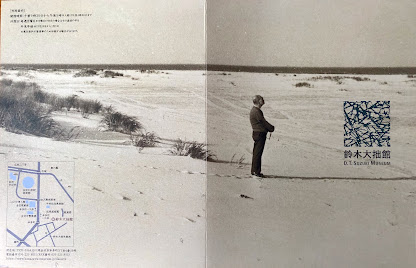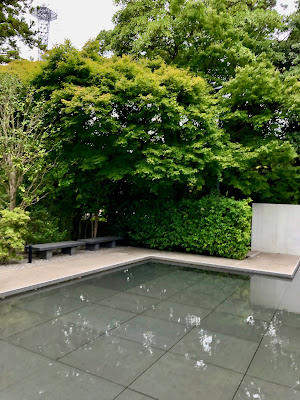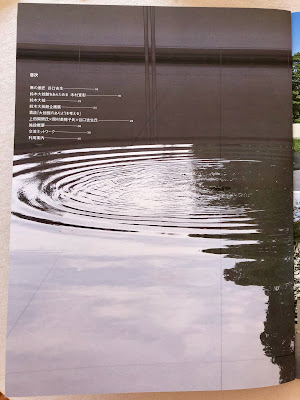目次 / Contents
1) 緑の小径から / From Midori-no-Komichi Path
1) 緑の小径から / From Midori-no-Komichi Path
2) 入館 / Enter to Museum
A. 入り口 / Entrance
B. 鈴木大拙 / D.T. Suzuki
C. 思想 / Thoughts
D.ことばについて / About Words
3) '水鏡の庭' / 'Water Mirror Garden'
4) カタログ / Pamphlet
 |
| 鈴木大拙館周辺案内マップ 鈴木大拙館 〒920-0964 石川県金沢市本多町三丁目4番20号 D.T. Suzuki Museum Area Guide Map D.T. Suzuki Museum 3-4-20 Honda-cho, Kanazawa City, Ishikawa Prefecture, 〒920-0964 |
1) 緑の小径から / From Midori-no-Komichi
訪れたいと思っていました。
金沢に住む、友人Sちゃんも以前から、観光の1つとして、候補に
挙げてくれていました。
ようやく、今回の金沢旅行で、実現できました。
行きました。
2つは、'緑の小径' をはさんでいる立地です。
鈴木大拙館の正規の入口から入る前に、鈴木大拙館の見どころの
"水鏡の庭" は、緑の小径から、垣間見ることができました。
From Midori-no-Komichi
I have always been interested in the D. T. Suzuki Museum : ★ / ★
and wanted to visit it.
My friend S Chan, who lives in Kanazawa, has also recommended visiting here.
Finally, this trip to Kanazawa made it possible.
In front of D.T. Suzuki Museum, S Chan and I went to Shofukaku Garden : ★.
The two are located either side of 'Midori-no-Komichi Path' : 'Green Path'.
Before entering through the official entrance of the D.T. Suzuki Museum, we were able to catch a glimpse of the "Water Mirror Garden", highlight of the Museum, from the 'Green Path'.
 |
| '思索空間棟' '水鏡の庭'の中心にある白い建物は、'思索空間棟'です。 'Contemplative Space Building' The white building in the centre of the 'Water Mirror Garden' is 'Contemplative Space Building'. |
 |
| '水鏡の庭'と名付けられた理由が わかります。 I can see why it was named 'Water Mirror Garden'. |
 |
| 入口脇から / From side of Entrance |
2) 入館 / Enter to Museum
A. 入り口 / Entrance
 |
| 入り口 竣工:2011年 2022年10月18日開館されました。 10月18日は、鈴木大拙の誕生日です。 設計 : 谷口 吉生 (タニグシ ヨシオ / 1937~) Entrance Completion in 2011 It opened on 18th of October, 2022. 18th of October is D.T. Suzuki's birthday. Design by Yoshio Taniguchi (1937~)  チケット / Tickets |
館内のほとんどの場所では撮影禁止です。
'水鏡の庭'には撮影は許されています。
Photography is prohibited in most areas of the museum.
Photography is permitted in the 'Water Mirror Garden'.
B. 鈴木大拙 / D.T. Suzuki
 |
| 鈴木大拙 スズキタイセツ / 1870 - 1966 Daisetsu Teitaro Suzuki : D.T. Suzuki 1870 - 1966 画像は下記より / This from below ★ |
先にも書いたように、私は、以前から、鈴木大拙館に行きたいと思っていましたが、それは建築に興味があったからでした。
鈴木大拙については、館を訪れたあとに多少知ることができました。
禅について、多数、英語で著し、翻訳もし、日本の禅文化を海外に
紹介しました。
(著書約100冊の内23冊が、英文)
'大拙' (本名は、貞太郎〈テイタロウ〉)は、居士号で、彼は出家していません。
釈 宗演 (シャクソウエン 1860 - 1919)に禅を学びました。
釈 宗演から、居士号・'大拙' を受けます。
1897年、米国へ渡り、出版に携わり、禅についての著作を英語で著しました。
英語を教え、終生交流した教え子に
柳 宗悦 (ヤナギ ムネヨシ : ソウエツ / 1889 - 1961)や
松方三郎 (マツカタ サブロウ / 1899 -1973) 等がいます。
1911年アメリカ人で神智学者のベアトリス・レイン (Beatrice Lane →ベアトリス・アースキン・レイン・スズキ:Beatrice Erskine Lane Suzuki / 1878 - 1939) と結婚します。
1921年に大谷大学教授に就任して、京都に転居し、同大学で、長年教鞭をとりました。
1963年、ノーベル平和賞にノミネートされています。
鈴木大拙が鎌倉とも縁があることを知り、自分とのつながりをわずかながら感じ、親近感を持ちました。
D.T. Suzuki
As I wrote earlier, I had always wanted to visit the D.T. Suzuki Museum, because I was interested in the architecture.
I was able to learn a little about Daisetsu Teitaro Suzuki :
D.T. Suzuki after visiting the museum.
D.T. Suzuki was a Buddhism scholar and doctor of literature from Kanazawa.
He had written and translated many books on Zen in English, and introduced Japanese Zen culture to the world.
(23 of his 100 books are in English)
'Daitetsu' (real name Teitaro) is a Koji name, and he had not entered into the priesthood.
(Koji : a Buddhist lay believer who practices at home without becoming a priest)
In 1892, he entered Imperial University (currently the University of Tokyo), where he learned Zen from Kōzen Imakita (1816 - 1892) and Sōen Shaku (1860 - 1919) of Enkaku-ji Temple in Kamakura, Kanagawa Prefecture.
From Sōen Shaku, he received the Koji, 'Dai Tetsu'.
In 1897, he went to the United States, where he worked as a publisher and wrote books on Zen in English.
He returned to Japan in 1909, lived at Engaku-ji Temple in Kamakura, and was assigned to Gakushūin.
He taught English and made friends with his students throughout his life.
Muneyoshi Yanagi (or Sōetsu Yanagi / 1889 - 1961) and
In 1911 he married the American theosophist, Beatrice Lane (→Beatrice Erskine Lane Suzuki / 1878 -1939).
In 1921, he became a professor at Ōtani University and moved to Kyoto where he taught for many years.
In his later years he lived in Kamakura, where he studied at the "Matsugaoka Bunko" (adjacent to Tokeiji Temple).
In 1963 he was nominated for the Nobel Peace Prize.
There is a graveyard at the Suzuki family graveyard in Nodayama Cemetery in Kanazawa City and also at Tokei-ji Temple in Kamakura.
Having found that D.T. Suzuki had a connection with Kamakura, I felt a faint sense of connection with him and felt a sense of familiarity with him.
C. 思想 / Thoughts
鈴木大拙の名を知ったばかりの私には、彼の思想についてまとめて、
ここに書くことができません。
いつものようにWikiから引用します(下記)。
"大拙は仏教の核心に、霊性の自覚を見出した。
大拙の生涯の思索の大部分はその《霊性の自覚》に向けられていたといってもよく、これが普遍性や世界性を持つと確信したので、仏教思想を欧米へも紹介したのである。
大拙が見出した仏教の霊性的自覚というのは《即非の論理》(ソクヒノロンリ) の体得である。"
とWikiには、説明されていますが、私は、禅への基本理解がないので、よくわかりません。
私は、彼の仏教における悟りとは、知識的展開の論理でなく、精神における到達なのだろうと理解しました。
精神は、法律や国境などの人間の決めたルール、分別は関係ないところに存在するからです。
ですが、購入したカタログの文面を読んで、大拙は、国境などの地球規模でなく、宇宙 (cosmos) 的な視野で捉えたのだと理解しました。
まあ、彼が生涯かけて深めた思想を私ごときがすぐに理解できるはずもなく....、鈴木大拙館を訪問したことによって、ちょっとこの件について考えてみるという行為で十分かと思います。
Thoughts
As I have only just come across the name of D.T. Suzuki, I cannot yet write about his thoughts here.
As usual, I'm quoting from the Japanese Wiki, below.
"D.T. Suzuki found spiritual awareness at the core of Buddhism.
It can be said that most of Suzuki life's thoughts were directed toward his 'Spiritual Awareness', and he was convinced that this had universality and worldwide appeal, so he introduced Buddhism to Europe and the United States.
The spiritual self-awareness of Buddhism that Suzuki discovered is the mastery of the 'Logic of Immediate Failure'. "
(Translated by me)
This is explained in the Wiki, but I don't understand it well because I don't have a basic understanding of Zen.
I understood his enlightenment in Buddhism to be attainment in the spirit rather than the logic of intellectual development.
This is because the spirit exists where laws, national borders, and other human-made rules and judgments do not matter.
However, when I read the contents of a pamphlet I bought, I understood that Suzuki had a perspective of the cosmos rather than of a global scale considering such matters as national borders.
Well, it's unlikely that someone like me would be able to immediately understand the thoughts that he spent his life deepening.
D.ことばについて / About Words
館内に持ち帰り自由な鈴木大拙の言葉の印刷物がありました。
その中から、無作為にいくつかを持ち帰りました。
鈴木大拙の思想を垣間見られるように思います。
About Words
There are prints of Suzuki's words that you can take home freely.
At random, I took some of them home.
I think I can catch a glimpse of Suzuki's thought.
3) '水鏡の庭' / 'Water Mirror Garden'
 |
| 松風閣庭園と緑の小径方面 Towards Shofukaku Garden and 'Midori-no-Komichi Path' : 'Green Path'. |
 |
| '思索空間棟' 'Contemplative Space Building'  |
 |
| 2つ入り口を通しての庭 屋内は来場者の思索の場と感じたので、 直接の撮影が憚られました。 なので、回廊からの2つの入り口を通し、 中をも捉える方法を選びました。 Garden Seen Through Two Entrances I felt that the indoor space was a place for visitors to contemplate, so I was hesitant to take pictures directly. Therefore I chose a way to capture the interior through two entrances from the corridor.  内部は、ちょっと茶室を思わせる雰囲気があります。 また一方で、ヘルシンキの "木の教会"、"カンッピ礼拝堂"も思い出しました。 茶室と "木の教会" はかなり違うイメージなのですが、 なんとなく、2つを思い出しました。 The interior has an atmosphere reminiscent of Cha-shitsu : tea room. Cha-shitsu in Japanese tradition is an architectural space designed to be used for tea ceremony gatherings. On the other hand, I also remembered the "Wooden Church" : "Kampin Chapel" in Helsinki. The images of a tea room and a "Wooden Church" are quite different, but somehow I remembered these two things. ヘルシンキの"木の教会" 2017年撮影 "Wooden Church" Photograph in 2017 |
フィンランドの'木の教会'について下記。
About "Wooden Church", below.
私の発想の多くは、水に由来します。
リフレクションは私の大好きな素材です。
リフレクションは、ファンタジー好きな私に別世界を感じさせます。
緑の木々、ガーデン、風のそよぎ、水音...
ここには、私の好きなものがたくさんあります。
Many of my ideas come from water.
Reflection is my favourite source.
As a fan of fantasy, reflections make me feel in, or of, another world.
Green trees, gardens, the breeze, the sound of water...
There are many things I like here.
4) カタログ / Pamphlet
屋内には、素敵な空間がたくさんあります。
ですが、撮影はできないので、綺麗な写真がたくさん載ってるいる
カタログを購入しました。
カタログには、鈴木大拙や鈴木大拙館に関しての記事もありますし、私が無作為に持ち帰ったプリントのシリーズもいくつか載っています。
購入してよかったと思いっています。
いくつかのカタログの写真をここに載せます。
 |
| カタログ デザイン:矢萩 喜從郎 (ヤハギ キジュウロウ / 1952~) 写真 : 北嶋 俊治 (キタジマ トシハル / ? ~) ; 建築写真家 Pamphlet Design by Kijuro Yahagi (1952~) Photography by Toshiharu Kitajima (?~), an architectural photographer |
Pamphlet
There are many lovely spaces inside.
However, we can't take pictures, so I bought a pamphlet with many beautiful photographs.
The pamphlet includes articles about Suzuki and the D.T. Suzuki Museum, as well as a series of prints I randomly brought home.
I'm glad I bought it.
Here are some pamphlet pictures.
カタログ内の館長・木村 宣彰 (キムラセンショウ / 1943 ~ ) 氏の文章を下に引用します。
"~ 本館は大拙の遺品の品々を展示する記念館ではない。
本館は、大拙の人柄とその思想を象徴し、在りしながらの大拙に接する施設である。"
なるほどね〜と納得する場所でした。
また、建築家、谷口吉生 氏にとっては、やりがいがあったのではないかと推測します。
通常、記念館や美術館や博物館などは、作品展示が主役で、建物は、それらを収める '箱'ですが、鈴木大拙館は、建物で、大拙の思想を表現できる可能性を持っていました...と思います。
谷口氏はよろこんで、この難題に取り組んだ様子がカタログ内の彼のコメントから感じられました。
写真は、私が初めて知った北嶋俊治によるものです。
北嶋氏は、建築撮影専門で、その世界では有名であり、多くの美術館、博物館などなどの撮影をしていると、この度知りました。
パンフレットは北嶋氏の写真集のように感じます。
何度みても飽きません。
買って本当によかったです。
Below is an excerpt from the pamphlet written by Senshō Kimura (1943 ~ ), the director of the museum.
"~ The main building is not a memorial hall that displays items belonging to D. T. Suzuki.
This museum is a facility that symbolizes the personality and thoughts of Suzuki."
Indeed, here is exactly like this.
Also, I guess that the architect, Yoshio Taniguchi, must have found it worthwhile.
Normally, memorial halls, art museums, museums and so on are mainly focused on exhibiting works, and the building is a 'Box' to house them, but the D. T. Suzuki Museum is not...I think.
In my view, Taniguchi was pleased, and it was felt from his comments in the pamphlet that he had enjoyed tackling this difficult brief.
The photographs are by Toshiharu Kitajima, who I first knew of.
Kitajima specializes in architectural photography, is famous in that world, and I found out that he has photographed many art museums, museums, etc.
The pamphlet feels like a photobook of Kitajima.
No matter how many times I have looked at them, I never get tired of them.
I'm really glad I bought this pamphlet.
 |
| 季節が変われば、ちがう景色、空間があることを この写真が伝えています。 This photograph tells us that when the season changes, we can see different scenes and spaces. |
金沢を訪れた際には、また、行ってみたいと思いました。
きっと夫Rも好きな場所なのではないかと思います。
Sちゃん、私をここに連れてきてくれて、ありがとう!
When I visit Kanazawa, I would like to come here again.
I'm sure my husband R would also find this a favourite place.
S Chan, thank you for bringing me here!








.jpeg)








.jpg)









